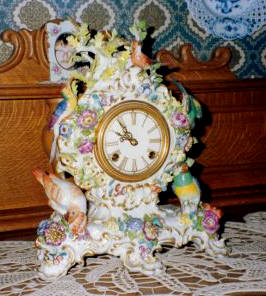| Homepage | News |
| Index A-Z | Address |
| Disclaimer of sammler.com | |
| Add to favorites | Email this page |
|
|
||||||||||||
Collecting Porcelain and CeramicsThis page describes the collecting of porcelain and ceramics. It introduces and lists the collecting of ceramics particularly valuable ceramics for collectors. |
 Meissen ceremonial clock with plastic flower decoration and songbirds. Estimated value almost 20,000 euros |
|
|
|
| Introduction and Information about Collecting Porcelain and Ceramics | Links | Mails |
| News | Valuable ceramics for Collectors | What to Consider when Collecting Ceramics |
|
Porcelain and ceramics collecting is a fascinating hobby
that has been enjoyed by many for centuries. It involves collecting
decorative and functional objects made from clay, porcelain, or other
materials, which are often intricately crafted and highly prized for their
beauty and historical significance.
Meissen Jubilee Plate 1910 When starting a porcelain and ceramics collection, it's
important to consider a few factors. First, it's important to do your
research and learn as much as possible about the objects you are interested
in collecting. This includes understanding the materials, techniques, and
styles used in creating them. It's also important to consider the condition
and rarity of the objects, as well as their provenance and historical
significance. Particularly Valuable ceramics for CollectorsThere are many different types of porcelain and ceramics that are highly valued by collectors. Here are a few examples:
Of course, there are many other types of porcelain and
ceramics that are highly valued by collectors, including Japanese porcelain,
French faience, and Italian majolica. The value of a particular piece will
depend on a variety of factors, including its age, rarity, condition, and
historical significance. ConclusionIn conclusion, porcelain and ceramics collecting is a rewarding hobby that offers a wealth of beauty and history to those who pursue it. Whether you are interested in ancient pottery or contemporary studio ceramics, there is a wide world of objects to explore and appreciate. With careful research and a discerning eye, porcelain and ceramics collecting can be a lifelong pursuit that brings joy and enrichment to your life. |
|
When collecting ceramics, there are several important factors to consider. Here are some key considerations for ceramic collectors:
Display and Preservation: Proper display and preservation are essential for maintaining the beauty and value of ceramics. Use appropriate display methods and protective measures, such as secure shelving, proper lighting, and careful handling, to safeguard your collection. Avoid exposing ceramics to extreme temperature changes, direct sunlight, or excessive humidity, as these can cause damage over time. ConclusionRemember to collect ceramics that genuinely resonate with your personal taste and appreciation. Developing a deep understanding and knowledge of ceramics will enhance your ability to identify quality pieces, appreciate their artistic value, and build a meaningful collection over time. |
| The short film shows sculptures from China and Asia! |
| The short film shows beer mugs from Bavarian breweries and also
custom-made mugs. So you can collect all kinds of beer mugs! |
| The short film shows beautiful collector's mugs with horse motifs. |
| If you have a message or information about ceramics that should be published send a mail to thomas@sammler.com
! Readers who can answer a published question should send the answer to the email address of the person who asked. :-) Thank you. |
| Home of sammler.com |
|
|
| Copyright © 1996 / 2025 sammler.com, Forchheim, Germany | Disclaimer of sammler.com / Datenschutzerklärung |